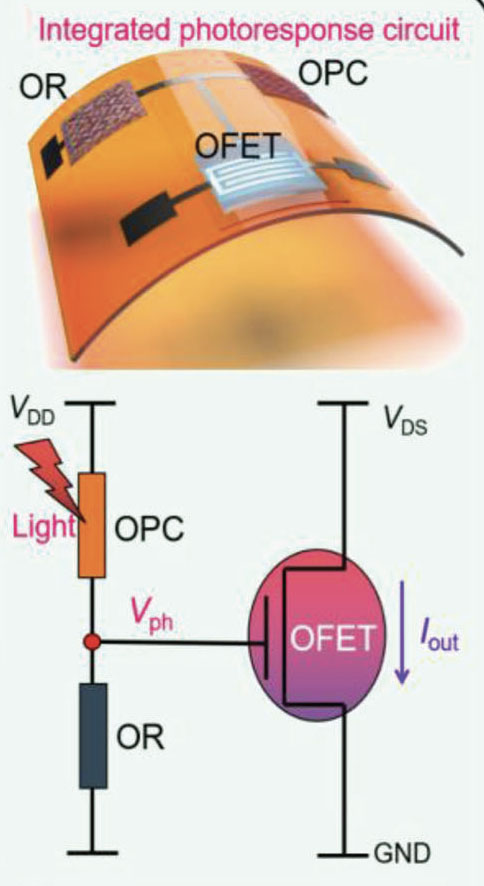| Aug 03, 2023 | |
New flexible sensor could enable continuous health monitoring |
|
| (Nanowerk Spotlight) Researchers have developed a new type of flexible sensor that could allow for continuous health monitoring during normal daily activities. The sensor, created by a team at Soochow University in China, can accurately measure subtle changes in light passing through blood vessels. This allows it to detect critical health signals like heart rate, blood oxygen levels, and blood pressure. | |
| The research has been publishe in Advanced Materials ("Boosting the Performance of Organic Photodetectors with a Solution-Processed Integration Circuit toward Ubiquitous Health Monitoring"). | |
| Photoplethysmography (PPG) is a non-invasive medical sensing technique that measures changes in the amount of light absorbed or reflected by blood vessels in living tissue. This technique provides valuable information about the cardiovascular, respiratory, and nervous systems. It is often used in clinical practice to monitor important physiological considerations such as heart rate, cardiac cycle, oxygen saturation level, and blood pressure. | |
| However, the development of photodetectors for PPG has been limited due to the mutual restraints among photo response, structure complexity, and fabrication cost. The researchers have found an effective route to dramatically boost the performance of organic photodetectors with a solution-processed integration circuit for health monitoring applications. | |
| The core innovation that the team demonstrated is integrating three components into their novel sensor: an organic photoconductor, an organic resistor, and an organic field-effect transistor (OFET). The photoconductor generates a small current when illuminated. This current is fed into the OFET, which amplifies it exponentially to boost the signal-to-noise ratio by over 100,000 times. This enables detecting faint physiological signals through the skin. | |
 |
|
| Schematic of the integrated photoresponse circuit consisting of OPC, OR, and OFET. (Reprinted with permission by Wiley-VCH Verlag) | |
| The solution-printed OFETs achieved an ultrahigh signal amplification efficiency of 37.1 S A-1, approaching the theoretical thermionic limit. The integration of the OFET with an organic photoconductor enabled the remarkable amplification of the photoresponse signal-to-noise ratio by more than four orders of magnitude, from 5.5 to 4.6 x 105. This level of sensitivity is sufficient to accurately extract physiological information from the PPG waveforms. | |
| “The OFET acts like a hearing aid to massively amplify the faint 'whisper' signals from the photoconductor,” explains Dr. Xiaohong Zhang, leader of the research team. “This gives us unprecedented sensitivity rivaling medical-grade sensors.” | |
| The researchers built the integrated sensor through a specialized printing process, allowing low-cost, large-scale production on flexible plastic substrates. Bending tests showed no degradation even after 3000 cycles. | |
| In proof-of-concept trials, the sensor generated clear photoplethysmogram (PPG) waveforms when attached to a fingertip. The rich waveform features allowed extracting heart rate, blood oxygen saturation, and blood pressure using only the optical PPG signals. | |
| “This demonstrates the power of our sensor for comprehensive health monitoring,” says Dr. Zhang. “The high sensitivity and flexible format open up possibilities for truly ubiquitous monitoring during exercise, sleep, and normal activities.” | |
| The team next aims to further improve the sensitivity for more challenging measurement locations like the wrist. They are also developing machine learning algorithms to continuously analyze the PPG signals for health insights. | |
| “The future possibilities are very exciting,” Dr. Zhang concludes. “With further development, this technology could enable continuous tracking of many health indicators without obstructing daily life.” | |
 By
Michael
Berger
– Michael is author of three books by the Royal Society of Chemistry:
Nano-Society: Pushing the Boundaries of Technology,
Nanotechnology: The Future is Tiny, and
Nanoengineering: The Skills and Tools Making Technology Invisible
Copyright ©
Nanowerk LLC
By
Michael
Berger
– Michael is author of three books by the Royal Society of Chemistry:
Nano-Society: Pushing the Boundaries of Technology,
Nanotechnology: The Future is Tiny, and
Nanoengineering: The Skills and Tools Making Technology Invisible
Copyright ©
Nanowerk LLC
|
|
|
Become a Spotlight guest author! Join our large and growing group of guest contributors. Have you just published a scientific paper or have other exciting developments to share with the nanotechnology community? Here is how to publish on nanowerk.com. |
|
